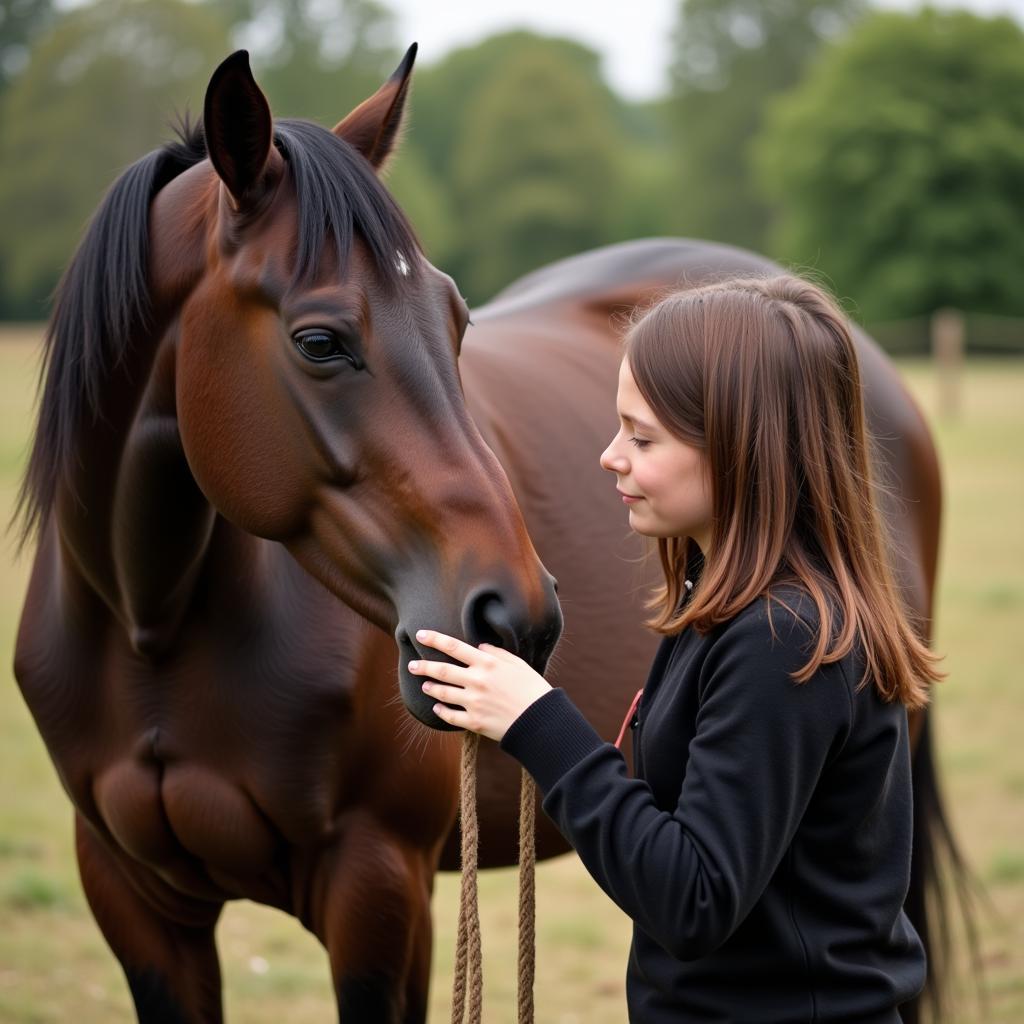Horses don’t lie. Their communication is a complex tapestry of subtle cues, body language, and vocalizations. Understanding these signals is crucial for building a strong bond and ensuring their well-being. This understanding goes beyond simply riding or caring for them; it’s about truly connecting with these magnificent creatures on a deeper level.
Horses communicate primarily through body language, which can be incredibly nuanced. A flick of the ear, a swish of the tail, even the tension in their muscles can convey a wealth of information about their emotional state, intentions, and physical comfort. While they may not speak our language, they speak volumes through their actions. Learning to interpret these signals is key to responsible horse ownership. Do you notice your horse pinning its ears back? That’s a clear sign of displeasure or aggression. A relaxed, drooping lip, on the other hand, indicates contentment. Observing and interpreting these subtle cues is essential for effective communication and training. Are you looking for gorgeous horses for sale? Then look no further than Justus Horses.
Decoding the Silent Language of Horses
Horses rely heavily on non-verbal cues to communicate. Recognizing and understanding these cues is fundamental to building a trusting relationship. For example, a horse that turns its head away might be feeling overwhelmed or fearful. Conversely, a horse that approaches you with a soft eye and relaxed posture likely feels comfortable and safe in your presence. By paying close attention to these silent signals, we can gain valuable insights into their thoughts and feelings. Recognizing these subtle nuances not only strengthens our connection with them but also allows us to anticipate their needs and respond appropriately. Are you interested in horses for sale in Medford Oregon? Justus Horses has a great selection.
The Expressive Power of Ears
A horse’s ears are incredibly expressive, acting as a barometer of their emotional state. Ears pricked forward indicate alertness and interest, while ears pinned back signal aggression or fear. Even slight rotations or twitching can reveal subtle shifts in their attention and mood.
Horses, like any other living creature, communicate their needs and feelings. They might whinny when they are hungry, paw the ground when they are impatient, or nudge you with their nose when they are seeking attention. By understanding their language, we can respond to their needs and build a stronger bond. We can also prevent misunderstandings that might lead to frustration or even dangerous situations. Horses are sensitive animals, and they rely on us to understand and respect their ways of communication.
Tail Tales: Understanding Equine Tail Language
The position and movement of a horse’s tail can also provide valuable insights into their emotional state. A swishing tail can indicate irritation or flies, while a clamped down tail often signifies fear or anxiety. A slightly raised and gently swaying tail, on the other hand, might indicate contentment and relaxation.
 Horse Tail Communication Signals and Meanings
Horse Tail Communication Signals and Meanings
Understanding these signals can be crucial in various situations, from everyday interactions to training and riding. Just like humans rely on facial expressions and body language, horses depend on their own unique ways to express themselves. Ignoring their cues could lead to miscommunication and even potentially dangerous situations. For example, a rider who fails to recognize a horse’s signs of discomfort might push the animal too hard, resulting in a negative experience for both.
Why “Horses Don’t Lie” Matters
The saying “horses don’t lie” reflects the genuine and unfiltered nature of their communication. They don’t have the capacity for deceit or manipulation like humans. Their responses are instinctive and honest reflections of their internal state. This inherent honesty makes them incredibly perceptive companions and partners. They can sense our emotions and often mirror them back to us, providing a unique opportunity for self-reflection and personal growth. Justus Horses offers Sho Glo for horses, which can help maintain their beautiful coats.
Building Trust and Connection
Understanding equine communication is the foundation for building a strong and trusting relationship with a horse. It allows us to communicate effectively, build mutual respect, and create a partnership based on understanding and empathy. This connection is not only rewarding but also essential for successful training and handling.
Enhancing Safety and Well-being
Recognizing and responding appropriately to a horse’s signals is crucial for ensuring their safety and well-being. By understanding their cues, we can anticipate potential problems, avoid dangerous situations, and create a positive and stress-free environment for them. Looking for the best fly masks for horses? Justus Horses can help you find the perfect fit.
 Horse and Human Connection Built on Trust and Communication
Horse and Human Connection Built on Trust and Communication
Conclusion: Listening to the Whispers of Equine Language
Horses don’t lie, and their communication is a constant stream of valuable information. By learning to listen to their whispers, observe their body language, and understand their vocalizations, we can forge deeper connections, enhance their well-being, and experience the true magic of these incredible animals. Remember, the more we understand their language, the better we can care for them and appreciate the unique bond we share. Are you interested in Peterstone horses? Learn more at Justus Horses.
FAQ
- How can I tell if my horse is happy?
- What are the signs of a stressed horse?
- How do horses express pain?
- What does it mean when a horse paws the ground?
- How can I improve my communication with my horse?
- What are some common misconceptions about horse communication?
- Where can I find more resources on understanding horse behavior?
Need more help? Contact us at Phone Number: 0772127271, Email: [email protected] Or visit us at QGM2+WX2, Vị Trung, Vị Thuỷ, Hậu Giang, Việt Nam. We have a 24/7 customer support team.